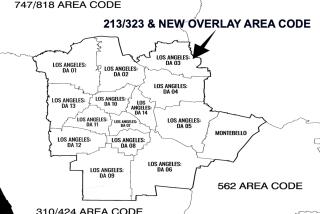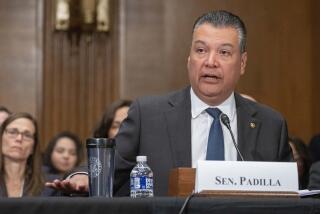Phone Numbers Grow Scarce in Information Age
- Share via
WASHINGTON — As the information age fuels an explosion of fax machines, cellular phones and other high-tech communications devices, government regulators and industry officials are scrambling to preserve an increasingly precious resource: the phone number.
A looming problem of telephone-number gridlock threatens to retard business growth and the development of new technologies. And it will also introduce new wrinkles in the dialing habits of millions of phone users now served by the North American dialing system, experts say.
The day of reckoning is fast approaching. The supply of three-digit North American telephone area codes--all of which have “0” or “1” as the middle number--will be exhausted within two years unless augmented by new kinds of three-digit area codes, phone company officials and telecommunications experts say.
“Within the last year, everything has come to a head,” said Eva Waskell, program director of Telestrategies, a McLean, Va., communications consulting group. “We cannot afford to wait (long) to have this resolved.”
While the public generally takes the telephone system for granted, there are fierce battles going on behind the scenes over who will control one of the communications industry’s most important functions--the allocation of telephone numbers. The winner will play a central role in determining how fast rapidly emerging new technologies can be accommodated.
Some cellular phone subscribers in the United States are already reporting delays in getting phone service as the rapidly expanding industry gobbles up an estimated 7,500 new telephone numbers a day.
Likewise, an explosion of home offices--with their attendant fax machines and computer modems--is fueling demand for extra phone lines. Some 14% of Pacific Bell’s residential customers now have two phone lines--a number that has risen sharply in the past five years.
With so much at stake, upstart communication service companies are already facing off against Bellcore, an arm of the seven regional phone companies that currently administers long distance area codes.
A growing number of firms want the Federal Communications Commission to mediate the dispute--a request that could delay Bellcore’s planned expansion of area codes as government regulators weigh the issue.
The FCC so far has stayed largely aloof, though it has sought advice from the communications industry on how best to administer telephone numbers.
Many industry experts say that hundreds of millions of dollars in new equipment will be needed to make the transition from the current numbering system, first established in 1947, to a new one.
While the obstacles are technical in nature, the fundamentals are not hard to grasp:
The current system relies on a limited pool of three-digit area codes that need the “0” or “1” as the middle digit to help telephone switching equipment to distinguish between area codes and the first three digits of a local exchange.
That limitation restricts the number of available area codes to about 150, each of which can support about 7.8 million seven-digit phone numbers. With the proliferation of multiple lines, cellular phones and new communications services, the available universe of numbers is being rapidly depleted.
By 1995, Bellcore plans to introduce about 640 new area codes using middle digits other than 0 and 1 that will roughly quadruple the current telephone number capacity and hopefully meet rising demand for another three decades.
But doing so will require a massive overhaul of the North American telephone infrastructure, including the reprogramming of telephone-company switching software and hardware.
Businesses--many of which have old telephone switchboards that only recognize current long distance codes--may be especially hard hit, while consumers will likely have a much harder time finding phone numbers through long-distance directory assistance because of the proliferation of area codes.
Callers will have to closely pinpoint neighborhoods in making directory assistance requests because of the area-code proliferation. That’s already a problem in Southern California, which now has seven area codes and is likely to get many more.
Critics want to wrest control of area codes from Bellcore. Providers of new communications services--such as cellular phones--are especially angry, claiming Bellcore is trying to protect the lucrative cellular business of the regional Bells by making it tough for other competitors to get telephone numbers.
But Ron Conners, who heads the numbering system for Bellcore in its Livingston, N.J., office, defends the company’s performance.
“We’ve done a good job of administering a phone numbering plan that has been the envy of the world,” Conners said. “We operate in a fishbowl, and the (phone number) assignments we make are public and subject to the oversight of the FCC. If anyone doesn’t like what we do, they can complain.”
Still, Conners conceded, the telephone system “will be in real difficulty” if industry disputes over Bellcore’s administration of area codes delays the introduction of the 640 additional new numbers beyond 1995.
Even if a timely transition is made, it will not come cheap. Few, if any, suppliers currently make equipment capable of recognizing area codes with middle digits other than 0 or 1.
Frustrated by its inability to find phone equipment able to handle the new codes, Wall Street giant Merrill Lynch recently issued an ultimatum to one manufacturer: Either make a switchboard that recognizes the new number combinations, or the brokerage would take its business elsewhere.
“We’ve got to kick companies in the butt” to get them to deal with the problem, said Raymond Liuzzo, an assistant vice president at the New York investment house. “They don’t realize a lot of users are going to be in a lot of trouble without new technology.”
Equipment makers have told Merrill Lynch that it will have to wait months--and spend thousands of additional dollars--to acquire a new private branch exchange (PBX) system that will recognize the new area codes, Liuzzo said. (PBX equipment allows communications both within a company and with the outside world.)
Even the regional phone companies are scrambling. As Pacific Telesis recently told the FCC, it is spending about $84 million to upgrade its switching and billing support systems in order to avoid exhausting the internal numerical codes needed to determine how to route calls to the proper long-distance carrier.
Yet, with communications technology evolving so fast, some experts say even 640 more area codes would be little more than a temporary solution. They are urging the industry to develop more expansive efforts--such as creating four-digit area codes--to avoid a recurrence of telephone number gridlock a few years down the road.
The expansion also won’t ease the squeeze on many telecommunication services now served by a single, “non-geographic” area code--such as toll-free 800-exchanges or 900-prefix information lines.
These numbers have grown in popularity in recent years and become an important business marketing tool, said Mike Hirsch, a vice president at the Cellular Telecommunications Industry Assn., a Washington trade group.
But as demand for such numbers grows in popularity, toll-free 800 exchanges or 900-prefix exchanges could quickly fill to capacity and Bellcore would have to find equally unusual code combinations to maintain the marketing value of these special telephone services, experts say.
Other new technologies are also certain to tax the available pool of phone numbers.
The FCC recently approved the development of a global satellite paging system that would let people send brief messages nearly anywhere around the world. Down the road, even more numbers will be needed for futuristic services such as wireless personal communications technologies.
One such system, called PCS, will permit users to communicate or perform computer functions with a device as portable and unobtrusive as a wristwatch.
Pressure is also building on local phone companies to designate three-digit local numbers--similar to the 911 emergency or 411 telephone directory service numbers--for new information services providers.
According to William F. Adler, executive director of federal regulatory relations for Pacific Telesis Group, the real problem is that phone demand generated by inventive service providers has temporarily outstripped the ability of planners to handle the load.
But an unsympathetic Peter P. Guggina, director of technical standards for MCI Communications Corp., said the FCC should strip Bellcore of its authority to administer the North American numbering plan, saying:
“We now have a process that’s too slow to cope with change.”
More to Read
Inside the business of entertainment
The Wide Shot brings you news, analysis and insights on everything from streaming wars to production — and what it all means for the future.
You may occasionally receive promotional content from the Los Angeles Times.










